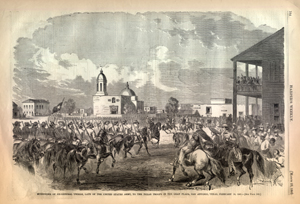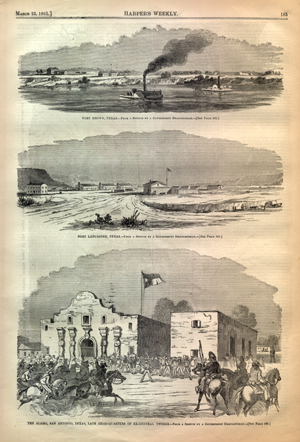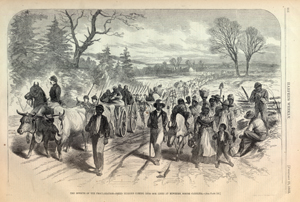Understanding Value
![]()
This Site:
Starting a Collection
Top Picks
Online Gallery
Search Page
Order
Winslow Homer
Thomas Nast
Ken Burns Civil War
|
|
I wanted to take a little space and discuss the issues associated with the "value" of these prints. As I was thinking about this section, I started to wonder- how many things that I purchase this year will have enduring value? I have a 9 year old daughter- how many things that I buy this year will be something cherished by HER children? I don't know if it is just me, but it appears that little that we buy these days has enduring value. |
My DVD player broke the other day, and when I saw how much it was to fix it, I simply threw it away and bought a new one. I guess that is the way it is today. My computer becomes obsolete before it has a chance to break. We live in a disposable society. I guess that is why I enjoy collecting these original prints. They are something with enduring value. Something that will be passed on for generations to come, and something that will not simply be used for a few years and then thrown away. I guess in today's fast paced world, it is nice to own something fine, something with a little class and character.
|
Having enduring value and being something fine, however, does not necessarily mean "expensive". The nice thing is that there are a number of examples of original Civil War prints that can be obtained for under $40, making them available to individuals of almost any means. In general, these prints go for anywhere between $100 and $500. I thought it would be helpful to discuss the issues that affect the value of a print. In general, there are three major factors affecting value; 1) Visual Impact, 2) Historical Significance, and 3) Condition. Probably the most important of these is visual impact. Most people purchase these prints to frame and display. People are generally looking for prints with significant eye appeal. |
|
While each print is special and has significance, some have more eye appeal than others. Really dramatic prints are simply worth more than prints without that same level of visual impact. Along with visual impact, historical significance is an important factor determining a the value of a print. For example, there will be many more people searching for a print of the Battle of Gettysburg than for, say, the Battle of Winchester. Because of this, the price on the Gettysburg print could be significantly more than the Winchester print (this is actually quite nice if you live in Winchester, and were looking for prints of local interest). Similarly, an original print of Abraham Lincoln will go for more than a portrait of General Butler. Another factor affecting the "historical significance" factor is the artist. All the illustrators for Harper's were simply superb, but some went on to become noted artists. Winslow Homer was one of the most popular artists of the 1800's, and he got his start as an illustrator for Harper's Weekly. Illustrations by Homer are among the most collected of all prints, and usually demand a significant premium.
The third factor affecting value is condition. In general, prints do not have to be in absolutely perfect condition to have high value. These prints are, after all, over 130 years old, and one would expect them to bear a few marks with their age. The prints can often have slight tears in the margins from years of handling. Many of these prints spent their life as part of a library archive, so they were handled throughout the years. In my collection, I usually repair these small margin tears with archive grade tape from the back side. Whatever you do, NEVER use common house tape such as scotch tape. This tape will quickly turn yellow. Basically any print with scotch tape repairs becomes completely worthless. This also points out that you need to know who you are dealing with when purchasing prints. I have seen many, many prints which have been repaired with scotch tape, and then sold to unwitting people. On the other hand, a few small margin tears with proper mending from the backside do not really negatively impact the value of the print. If the tear extends through the margin, and into the print itself, then the value us affected.
Another issue affecting condition is "foxing". Foxing is a term used for a region of the print that is turning a brownish color faster than the rest of the print. A little light foxing is normal, and expected, and does not affect the value of the print. Heavy foxing that is large and pronounced, and distracting does affect value.
|
|
Another issue to consider is the overall neatness of the edge of the print. Before a print is framed, it looks better (in some peoples mind anyway) with a crisp clean edge. Because of this, some dealers will go in with a paper cutter and trim off a ragged edge, and leave a smooth crisp edge on the print. The problem with this is that you are losing part of the margin that is really needed when the print is matted and framed. In my mind, trimming the edge is a really bad thing to do. |
If the edge is a little ragged, it will be covered up by the mat when it is framed. It is not unusual for prints to have a rough edge. I think it is much better to leave the print in the original condition, and know that the rough edge will not show when the print is framed. When I sell prints, if the customer requests it, I can trim the edge, but I personally strongly recommend against it.
Another issue to discuss deals specifically with the "centerfold" prints. The nice thing about the centerfold prints is that they are twice as big, measuring about 16x20. Since these prints are "centerfolds", there is a fold line running down the center of the print. In addition, because these newspapers were "sewn" into large volumes, these centerfold prints usually have about 6 or so small (about 1mm) holes running down the center of the print. I usually repair these small holes with very small pieces of archive grade tape on the backside. You usually have to look pretty closely to find the holes. The fold line and holes are really just part of getting the larger pictures. In general the fold and holes do not detract from the print, and are more than compensated for by the impact of the larger prints.
In conclusion, the price of a given print is determined by its visual impact, historical significance and condition. These combine to really say that supply and demand determine the cost.
![]()
|
Email us at: paul@sonofthesouth.net. Copyright © 2003-2018 Son of the South.
|
|
|
|
Are you Scared and Confused? Click Here to read My Snake Story, a story of hope and encouragement, to help you face your fears. |
||


